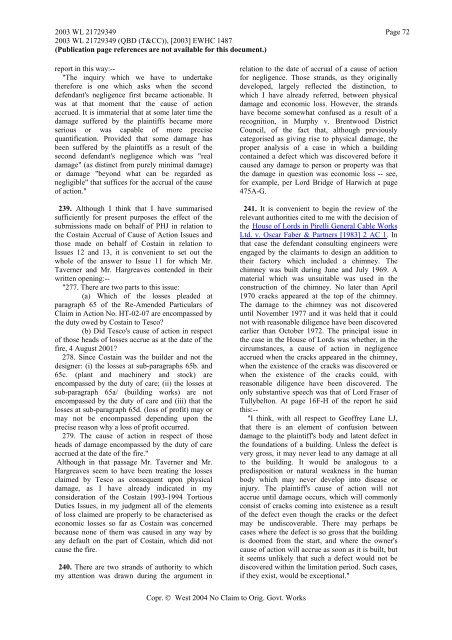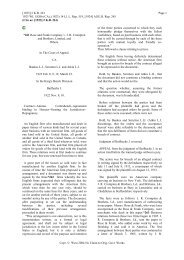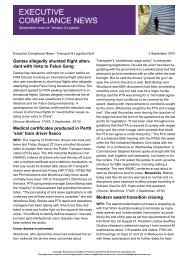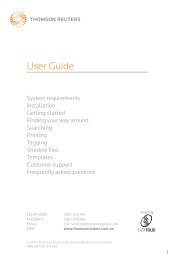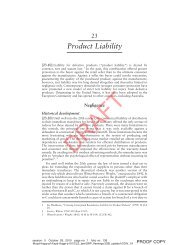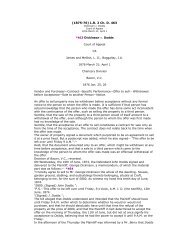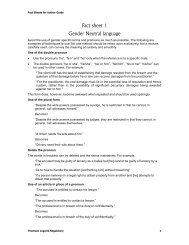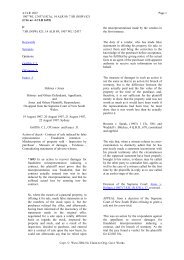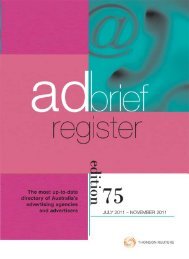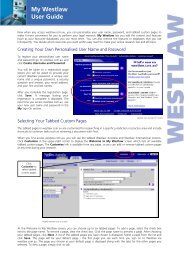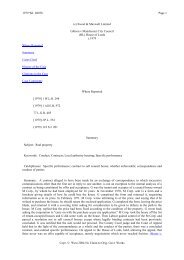Tesco v Constain - Thomson Reuters
Tesco v Constain - Thomson Reuters
Tesco v Constain - Thomson Reuters
Create successful ePaper yourself
Turn your PDF publications into a flip-book with our unique Google optimized e-Paper software.
2003 WL 21729349 Page 722003 WL 21729349 (QBD (T&CC)), [2003] EWHC 1487(Publication page references are not available for this document.)report in this way:--"The inquiry which we have to undertaketherefore is one which asks when the seconddefendant's negligence first became actionable. Itwas at that moment that the cause of actionaccrued. It is immaterial that at some later time thedamage suffered by the plaintiffs became moreserious or was capable of more precisequantification. Provided that some damage hasbeen suffered by the plaintiffs as a result of thesecond defendant's negligence which was "realdamage" (as distinct from purely minimal damage)or damage "beyond what can be regarded asnegligible" that suffices for the accrual of the causeof action."239. Although I think that I have summarisedsufficiently for present purposes the effect of thesubmissions made on behalf of PHJ in relation tothe Costain Accrual of Cause of Action Issues andthose made on behalf of Costain in relation toIssues 12 and 13, it is convenient to set out thewhole of the answer to Issue 11 for which Mr.Taverner and Mr. Hargreaves contended in theirwritten opening:--"277. There are two parts to this issue:(a) Which of the losses pleaded atparagraph 65 of the Re-Amended Particulars ofClaim in Action No. HT-02-07 are encompassed bythe duty owed by Costain to <strong>Tesco</strong>?(b) Did <strong>Tesco</strong>'s cause of action in respectof those heads of losses accrue as at the date of thefire, 4 August 2001?278. Since Costain was the builder and not thedesigner: (i) the losses at sub-paragraphs 65b. and65c. (plant and machinery and stock) areencompassed by the duty of care; (ii) the losses atsub-paragraph 65a/ (building works) are notencompassed by the duty of care and (iii) that thelosses at sub-paragraph 65d. (loss of profit) may ormay not be encompassed depending upon theprecise reason why a loss of profit occurred.279. The cause of action in respect of thoseheads of damage encompassed by the duty of careaccrued at the date of the fire."Although in that passage Mr. Taverner and Mr.Hargreaves seem to have been treating the lossesclaimed by <strong>Tesco</strong> as consequent upon physicaldamage, as I have already indicated in myconsideration of the Costain 1993-1994 TortiousDuties Issues, in my judgment all of the elementsof loss claimed are properly to be characterised aseconomic losses so far as Costain was concernedbecause none of them was caused in any way byany default on the part of Costain, which did notcause the fire.240. There are two strands of authority to whichmy attention was drawn during the argument inrelation to the date of accrual of a cause of actionfor negligence. Those strands, as they originallydeveloped, largely reflected the distinction, towhich I have already referred, between physicaldamage and economic loss. However, the strandshave become somewhat confused as a result of arecognition, in Murphy v. Brentwood DistrictCouncil, of the fact that, although previouslycategorised as giving rise to physical damage, theproper analysis of a case in which a buildingcontained a defect which was discovered before itcaused any damage to person or property was thatthe damage in question was economic loss -- see,for example, per Lord Bridge of Harwich at page475A-G.241. It is convenient to begin the review of therelevant authorities cited to me with the decision ofthe House of Lords in Pirelli General Cable WorksLtd. v. Oscar Faber & Partners [1983] 2 AC 1. Inthat case the defendant consulting engineers wereengaged by the claimants to design an addition totheir factory which included a chimney. Thechimney was built during June and July 1969. Amaterial which was unsuitable was used in theconstruction of the chimney. No later than April1970 cracks appeared at the top of the chimney.The damage to the chimney was not discovereduntil November 1977 and it was held that it couldnot with reasonable diligence have been discoveredearlier than October 1972. The principal issue inthe case in the House of Lords was whether, in thecircumstances, a cause of action in negligenceaccrued when the cracks appeared in the chimney,when the existence of the cracks was discovered orwhen the existence of the cracks could, withreasonable diligence have been discovered. Theonly substantive speech was that of Lord Fraser ofTullybelton. At page 16F-H of the report he saidthis:--"I think, with all respect to Geoffrey Lane LJ,that there is an element of confusion betweendamage to the plaintiff's body and latent defect inthe foundations of a building. Unless the defect isvery gross, it may never lead to any damage at allto the building. It would be analogous to apredisposition or natural weakness in the humanbody which may never develop into disease orinjury. The plaintiff's cause of action will notaccrue until damage occurs, which will commonlyconsist of cracks coming into existence as a resultof the defect even though the cracks or the defectmay be undiscoverable. There may perhaps becases where the defect is so gross that the buildingis doomed from the start, and where the owner'scause of action will accrue as soon as it is built, butit seems unlikely that such a defect would not bediscovered within the limitation period. Such cases,if they exist, would be exceptional."Copr. © West 2004 No Claim to Orig. Govt. Works


